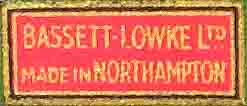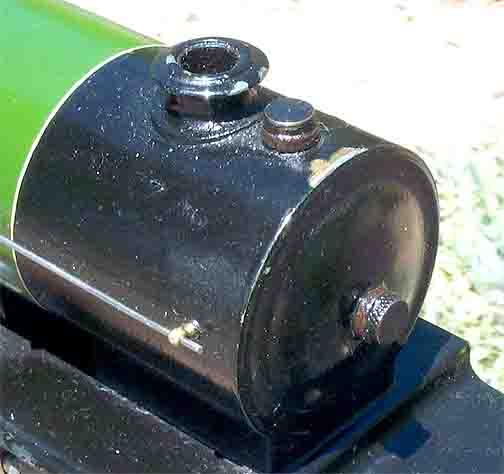
Back to Loco of the Month homepage
Back to Sidestreet Bannerworks
.
June 2004
Bassett-Lowke “Super Enterprise” 4-6-0
by Marc Horovitz

Bassett-Lowke is, arguably, the best-know model-railway manufacturer in the world. Wenman J. Bassett-Lowke produced his first catalog in 1900. The company imported and produced models into the 1960s. Today the name is owned by Corgi, who acquired it in 1996. Bassett-Lowke offered trains in all gauges up to 15" and in all modes of power (clockwork, steam, and electric). They were also well known for their ship models, some of which graced the board rooms of the largest steamship companies of the time.
I thought that, for the 50th locomotive in this series, I would have a look at the very first live-steam locomotive I ever acquired, around 25 years ago. This is the Bassett-Lowke "Super Enterprise". My example is green and lettered for the LNER (London & North Eastern Railway). It was produced (according to the book The Bassett-Lowke Story by Roland Fuller) in 1937. Also in this year were produced engines painted and lettered for the LMS, SR, and BR. The book indicates that the "Super Enterprise" was made from the early 1930s into the 1950s.
The locomotive is mechanically similar in most respects to the company's 2-6-0, but is not nearly as common. It features a simple pot boiler fired by a vaporizing-spirit burner held in place with a clip. In the cab is a throttle, a level plug that can be used to fill the boiler to the proper level, and a whistle of little value beyond that of ornamentation. There's a toy-type safety valve atop the boiler. This was originally concealed beneath a steam dome, made of a simple brass pressing with a hole in the middle through which projected the stem of the safety valve. These are commonly missing.
The engine has two, double-acting cylinders with inside piston valves controlled by slip eccentrics (the Mogul is controlled by a rotary reversing valve). A displacement lubricator resides in the smokebox. A filler plug for the lubricator is just in front of the stack and a drain plug is located in the middle of the smokebox front. The tender does nothing but follow along behind.
The burner is interesting. This type was commonly used in Bassett-Lowke's lower-end models. Alcohol (spirit) is held in a tank beneath the cab. A tube brings the fuel forward to a riser, inside of which is a wick to draw the meths up. Just behind the riser is a pilot wick whose job it is to preheat the burner tube. The burner tube is attached to the riser and is perforated with a row of little holes. When the pilot wick is lit, it begins heating the burner tube. As the alcohol inside heats, it begins to vaporize and come out the row of holes. As soon as this happens, the vapor ignites, producing a series of tiny but very hot flames atop the burner tube. It is these that heat the boiler. The burners in these engines are not very well shielded, which makes them particularly susceptible to the slightest breeze. Unlike wick fires, this one is easily blown out.
My example is typical of any well-used model of this type. The sides of the boiler are charred and the paint is coming off the splashers and frames.
The run
This engine hadn't been run since I got it 25 years ago, so I figured an air test would be in order. I oiled it all around and made sure everything turned smoothly. Then I removed the safety valve, plugged in the air line, and turned on the compressor. With the throttle open, the engine ran smoothly and strongly. Time to light a fire.
Although it had been warm outside, the wind howled all day long and I didn't know if I'd be able to get a run in. However, it calmed in the evening and I took the engine out around sunset. It was still and mild and the air was sparkling clear—a perfect night for a steamup. Earlier in the day I had cleared the track of encroaching plant material (the first pruning of the season), so it was ready to go.
Steam oil, water, and meths were duly applied. After a few false starts in getting the burner going, all was well. I checked the status of the pressure via the peanut whistle, which let out a high-pitched squeak that could be heard all over the garden. When all seemed ready, I opened the throttle and gave the engine a push. Not much happened. I let it cook a little longer, then tried again. This time I could feel the steam in the cylinders. Slowly, after 25 years on a shelf, the 67-year-old engine came alive again.
It slowly gained speed until it was running wide open, which was not at all fast. It clattered around the railway lap after lap, the hollow tinplate tender rattling along behind. Nothing can match the sound of a tinplate box on wheels. This was great! A bit of living history, recreating the same sights, sounds, and smells experienced by garden railroaders more than a half century ago.
I usually run narrow-gauge engines, so seeing this standard-gauge 0-scale locomotive chugging through the garden, a wisp of exhaust steam at the stack, was a real treat. It looked grand! I got more satisfaction out of running this ancient wee beastie than I get out of running much more modern, bigger, sophisticated engines. I'll have to give it an airing more often.
.

|
|
|
| Builder | Bassett-Lowke Ltd. (Great Britain) |
| Date built | 1937 |
| Gauge | 32mm |
| Scale | 7mm (0 scale) |
| Boiler | Pot |
| Fittings | Safety valve, throttle, whistle |
| Fuel | Alcohol |
| Blow-off pressure | 15 psi |
| Cylinders | Two, double-acting piston-valve |
| Reversing gear | Slip eccentrics |
| Lubricator | Displacement |
| Dimensions | Length (including tender), 16-5/8" over the end beams; width, 2-1/2"; height, 4" |

The right side shows much the same fire damage as the left. This locomotive is a classic of brass and tinplate construction. The boiler is rolled brass, seamed on the bottom.
.
Below: The lubricator is filled through the plug just in front of the smokestack and drained from the one in the front of the smokebox door.
.




Above: The burner. The holes along the top are where the vaporized alcohol ignites. The pilot wick is the little, short tube behind the riser.
Below: The simple cylinder has no glands or seals. The piston valves are inside, between the frames.
.

Back to Loco of the Month home page
Back to Sidestreet Bannerworks home page
This page and its contents
Copyright Sidestreet Bannerworks, 2004